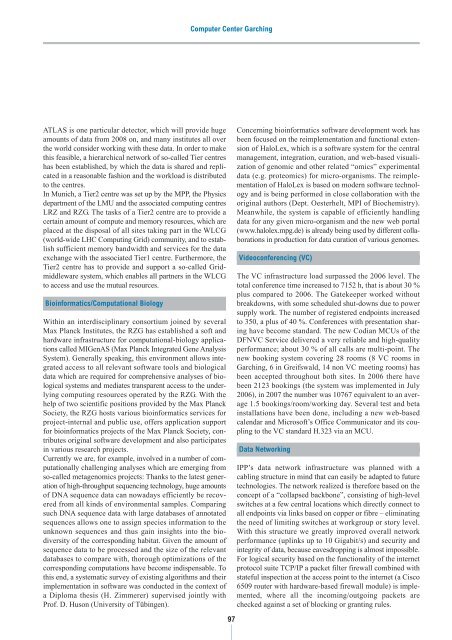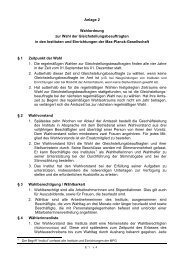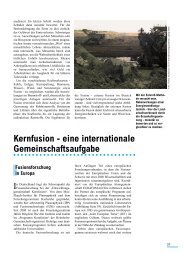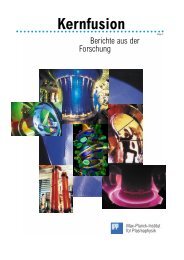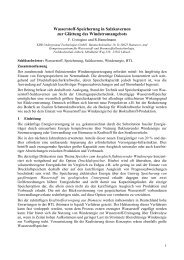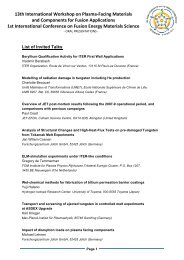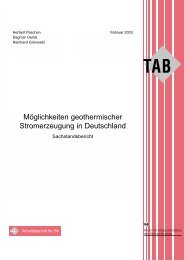IPP Annual Report 2007 - Max-Planck-Institut für Plasmaphysik ...
IPP Annual Report 2007 - Max-Planck-Institut für Plasmaphysik ...
IPP Annual Report 2007 - Max-Planck-Institut für Plasmaphysik ...
Create successful ePaper yourself
Turn your PDF publications into a flip-book with our unique Google optimized e-Paper software.
ATLAS is one particular detector, which will provide huge<br />
amounts of data from 2008 on, and many institutes all over<br />
the world consider working with these data. In order to make<br />
this feasible, a hierarchical network of so-called Tier centres<br />
has been established, by which the data is shared and replicated<br />
in a reasonable fashion and the workload is distributed<br />
to the centres.<br />
In Munich, a Tier2 centre was set up by the MPP, the Physics<br />
department of the LMU and the associated computing centres<br />
LRZ and RZG. The tasks of a Tier2 centre are to provide a<br />
certain amount of compute and memory resources, which are<br />
placed at the disposal of all sites taking part in the WLCG<br />
(world-wide LHC Computing Grid) community, and to establish<br />
sufficient memory bandwidth and services for the data<br />
exchange with the associated Tier1 centre. Furthermore, the<br />
Tier2 centre has to provide and support a so-called Gridmiddleware<br />
system, which enables all partners in the WLCG<br />
to access and use the mutual resources.<br />
Bioinformatics/Computational Biology<br />
Within an interdisciplinary consortium joined by several<br />
<strong>Max</strong> <strong>Planck</strong> <strong>Institut</strong>es, the RZG has established a soft and<br />
hardware infrastructure for computational-biology applications<br />
called MIGenAS (<strong>Max</strong> <strong>Planck</strong> Integrated Gene Analysis<br />
System). Generally speaking, this environment allows integrated<br />
access to all relevant software tools and biological<br />
data which are required for comprehensive analyses of biological<br />
systems and mediates transparent access to the underlying<br />
computing resources operated by the RZG. With the<br />
help of two scientific positions provided by the <strong>Max</strong> <strong>Planck</strong><br />
Society, the RZG hosts various bioinformatics services for<br />
project-internal and public use, offers application support<br />
for bioinformatics projects of the <strong>Max</strong> <strong>Planck</strong> Society, contributes<br />
original software development and also participates<br />
in various research projects.<br />
Currently we are, for example, involved in a number of computationally<br />
challenging analyses which are emerging from<br />
so-called metagenomics projects: Thanks to the latest generation<br />
of high-throughput sequencing technology, huge amounts<br />
of DNA sequence data can nowadays efficiently be recovered<br />
from all kinds of environmental samples. Comparing<br />
such DNA sequence data with large databases of annotated<br />
sequences allows one to assign species information to the<br />
unknown sequences and thus gain insights into the biodiversity<br />
of the corresponding habitat. Given the amount of<br />
sequence data to be processed and the size of the relevant<br />
databases to compare with, thorough optimizations of the<br />
corresponding computations have become indispensable. To<br />
this end, a systematic survey of existing algorithms and their<br />
implementation in software was conducted in the context of<br />
a Diploma thesis (H. Zimmerer) supervised jointly with<br />
Prof. D. Huson (University of Tübingen).<br />
Computer Center Garching<br />
97<br />
Concerning bioinformatics software development work has<br />
been focused on the reimplementation and functional extension<br />
of HaloLex, which is a software system for the central<br />
management, integration, curation, and web-based visualization<br />
of genomic and other related “omics” experimental<br />
data (e.g. proteomics) for micro-organisms. The reimplementation<br />
of HaloLex is based on modern software technology<br />
and is being performed in close collaboration with the<br />
original authors (Dept. Oesterhelt, MPI of Biochemistry).<br />
Meanwhile, the system is capable of efficiently handling<br />
data for any given micro-organism and the new web portal<br />
(www.halolex.mpg.de) is already being used by different collaborations<br />
in production for data curation of various genomes.<br />
Videoconferencing (VC)<br />
The VC infrastructure load surpassed the 2006 level. The<br />
total conference time increased to 7152 h, that is about 30 %<br />
plus compared to 2006. The Gatekeeper worked without<br />
breakdowns, with some scheduled shut-downs due to power<br />
supply work. The number of registered endpoints increased<br />
to 350, a plus of 40 %. Conferences with presentation sharing<br />
have become standard. The new Codian MCUs of the<br />
DFNVC Service delivered a very reliable and high-quality<br />
performance; about 30 % of all calls are multi-point. The<br />
new booking system covering 28 rooms (8 VC rooms in<br />
Garching, 6 in Greifswald, 14 non VC meeting rooms) has<br />
been accepted throughout both sites. In 2006 there have<br />
been 2123 bookings (the system was implemented in July<br />
2006), in <strong>2007</strong> the number was 10767 equivalent to an average<br />
1.5 bookings/room/working day. Several test and beta<br />
installations have been done, including a new web-based<br />
calendar and Microsoft’s Office Communicator and its coupling<br />
to the VC standard H.323 via an MCU.<br />
Data Networking<br />
<strong>IPP</strong>’s data network infrastructure was planned with a<br />
cabling structure in mind that can easily be adapted to future<br />
technologies. The network realized is therefore based on the<br />
concept of a “collapsed backbone”, consisting of high-level<br />
switches at a few central locations which directly connect to<br />
all endpoints via links based on copper or fibre – eliminating<br />
the need of limiting switches at workgroup or story level.<br />
With this structure we greatly improved overall network<br />
performance (uplinks up to 10 Gigabit/s) and security and<br />
integrity of data, because eavesdropping is almost impossible.<br />
For logical security based on the functionality of the internet<br />
protocol suite TCP/IP a packet filter firewall combined with<br />
stateful inspection at the access point to the internet (a Cisco<br />
6509 router with hardware-based firewall module) is implemented,<br />
where all the incoming/outgoing packets are<br />
checked against a set of blocking or granting rules.


